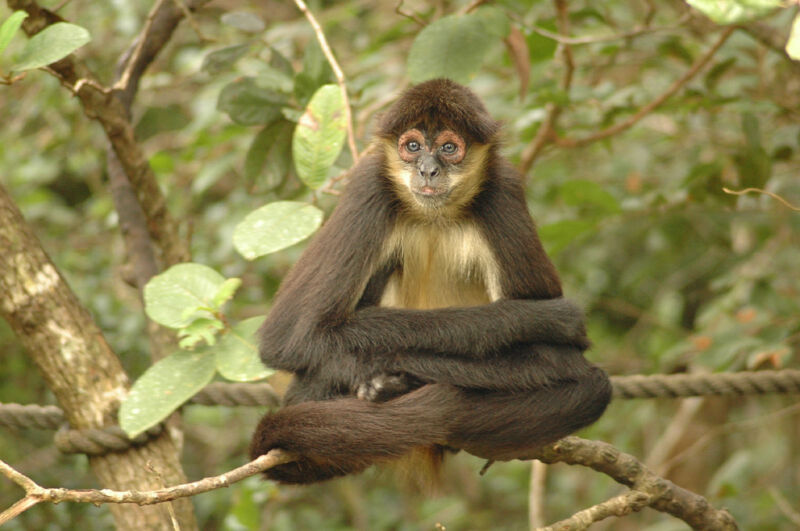When diplomacy fails: After gifts, Teotihuacan turned on Maya cities
The monkey is the oldest known captive, exported primate in Mesoamerica.

Spider monkeys don’t live anywhere near the central Mexican highlands, including the area around what’s now Mexico City, once the home of Teotihuacan. So when University of California, Riverside, archaeologist Nawa Sugiyama and her colleagues found the 1,700-year-old skeleton of one buried alongside other offerings in a pyramid in the city’s ceremonial center, they knew it must have come from far afield—such as somewhere in the territory of what was then a neighboring political power, the Maya. And the little primate hints at a previously unsuspected history of diplomatic links between Teotihuacan’s rulers and Maya kingdoms further south.
A diplomatic gift
Sugiyama and her colleagues found the skeleton interred as part of a ritual offering deep inside one of the three pyramids that make up the Plaza of the Columns complex in the ceremonial district of ancient Teotihuacan. It was found alongside a trove of jade figurines that were traced by their chemical makeup to the Motagua Valley in what’s now central Guatemala. There were also finely worked obsidian blades and shell ornaments, along with the remains of other animal sacrifices, including an eagle, a puma, and several rattlesnakes.
No primates (other than humans) live in the region around what’s now Mexico City, and a spider monkey would have been “an exotic curiosity, alien to the high elevations of Teotihuacan,” as Sugiyama and her colleagues describe it in their paper.
Sugiyama and her colleagues say the ill-fated monkey was probably part of a gift to the Teotihuacan’s rulers from a neighboring Maya kingdom. And although the monkey was captured and brought to Teotihuacan as a sacrifice, evidence in its bones and teeth suggests that it spent at least a couple of years in the city first. Sugiyama and her colleagues suggest it was likely on public display—allowing Teotihuacan’s rulers to show off how their prestige and power had brought the city such a rare gift.
It was, more or less, the ancient version of China’s gift of two pandas, Ling-Ling and Hsing-Hsing, to the US in 1972, say Sugiyama and her colleagues.
“As millions of tourists celebrated the life of Ling-Ling and Hsing-Hsing at the National Zoo, the gift of the spider monkey who likely resided, and thus was observed by the public, at the Plaza of the Columns complex held important sociopolitical implications,” they wrote. Of course, Ling-Ling and Hsing-Hsing didn’t get buried alive in a pyramid at the end of their tenure at the National Zoo—but, well, cultural differences.
Bones from the monkey and the other sacrifices radiocarbon dated to between 250 and 300 CE. That makes the spider monkey the oldest evidence of diplomatic ties between the Teotihuacan and the Maya, and it could upend what historians know about relations between the two powers.
When diplomacy fails: After gifts, Teotihuacan turned on Maya cities
The monkey is the oldest known captive, exported primate in Mesoamerica.

Spider monkeys don’t live anywhere near the central Mexican highlands, including the area around what’s now Mexico City, once the home of Teotihuacan. So when University of California, Riverside, archaeologist Nawa Sugiyama and her colleagues found the 1,700-year-old skeleton of one buried alongside other offerings in a pyramid in the city’s ceremonial center, they knew it must have come from far afield—such as somewhere in the territory of what was then a neighboring political power, the Maya. And the little primate hints at a previously unsuspected history of diplomatic links between Teotihuacan’s rulers and Maya kingdoms further south.
A diplomatic gift
Sugiyama and her colleagues found the skeleton interred as part of a ritual offering deep inside one of the three pyramids that make up the Plaza of the Columns complex in the ceremonial district of ancient Teotihuacan. It was found alongside a trove of jade figurines that were traced by their chemical makeup to the Motagua Valley in what’s now central Guatemala. There were also finely worked obsidian blades and shell ornaments, along with the remains of other animal sacrifices, including an eagle, a puma, and several rattlesnakes.
No primates (other than humans) live in the region around what’s now Mexico City, and a spider monkey would have been “an exotic curiosity, alien to the high elevations of Teotihuacan,” as Sugiyama and her colleagues describe it in their paper.
Sugiyama and her colleagues say the ill-fated monkey was probably part of a gift to the Teotihuacan’s rulers from a neighboring Maya kingdom. And although the monkey was captured and brought to Teotihuacan as a sacrifice, evidence in its bones and teeth suggests that it spent at least a couple of years in the city first. Sugiyama and her colleagues suggest it was likely on public display—allowing Teotihuacan’s rulers to show off how their prestige and power had brought the city such a rare gift.
It was, more or less, the ancient version of China’s gift of two pandas, Ling-Ling and Hsing-Hsing, to the US in 1972, say Sugiyama and her colleagues.
“As millions of tourists celebrated the life of Ling-Ling and Hsing-Hsing at the National Zoo, the gift of the spider monkey who likely resided, and thus was observed by the public, at the Plaza of the Columns complex held important sociopolitical implications,” they wrote. Of course, Ling-Ling and Hsing-Hsing didn’t get buried alive in a pyramid at the end of their tenure at the National Zoo—but, well, cultural differences.
Bones from the monkey and the other sacrifices radiocarbon dated to between 250 and 300 CE. That makes the spider monkey the oldest evidence of diplomatic ties between the Teotihuacan and the Maya, and it could upend what historians know about relations between the two powers.
When diplomacy fails: After gifts, Teotihuacan turned on Maya cities
The monkey is the oldest known captive, exported primate in Mesoamerica.

Spider monkeys don’t live anywhere near the central Mexican highlands, including the area around what’s now Mexico City, once the home of Teotihuacan. So when University of California, Riverside, archaeologist Nawa Sugiyama and her colleagues found the 1,700-year-old skeleton of one buried alongside other offerings in a pyramid in the city’s ceremonial center, they knew it must have come from far afield—such as somewhere in the territory of what was then a neighboring political power, the Maya. And the little primate hints at a previously unsuspected history of diplomatic links between Teotihuacan’s rulers and Maya kingdoms further south.
A diplomatic gift
Sugiyama and her colleagues found the skeleton interred as part of a ritual offering deep inside one of the three pyramids that make up the Plaza of the Columns complex in the ceremonial district of ancient Teotihuacan. It was found alongside a trove of jade figurines that were traced by their chemical makeup to the Motagua Valley in what’s now central Guatemala. There were also finely worked obsidian blades and shell ornaments, along with the remains of other animal sacrifices, including an eagle, a puma, and several rattlesnakes.
No primates (other than humans) live in the region around what’s now Mexico City, and a spider monkey would have been “an exotic curiosity, alien to the high elevations of Teotihuacan,” as Sugiyama and her colleagues describe it in their paper.
Sugiyama and her colleagues say the ill-fated monkey was probably part of a gift to the Teotihuacan’s rulers from a neighboring Maya kingdom. And although the monkey was captured and brought to Teotihuacan as a sacrifice, evidence in its bones and teeth suggests that it spent at least a couple of years in the city first. Sugiyama and her colleagues suggest it was likely on public display—allowing Teotihuacan’s rulers to show off how their prestige and power had brought the city such a rare gift.
It was, more or less, the ancient version of China’s gift of two pandas, Ling-Ling and Hsing-Hsing, to the US in 1972, say Sugiyama and her colleagues.
“As millions of tourists celebrated the life of Ling-Ling and Hsing-Hsing at the National Zoo, the gift of the spider monkey who likely resided, and thus was observed by the public, at the Plaza of the Columns complex held important sociopolitical implications,” they wrote. Of course, Ling-Ling and Hsing-Hsing didn’t get buried alive in a pyramid at the end of their tenure at the National Zoo—but, well, cultural differences.
Bones from the monkey and the other sacrifices radiocarbon dated to between 250 and 300 CE. That makes the spider monkey the oldest evidence of diplomatic ties between the Teotihuacan and the Maya, and it could upend what historians know about relations between the two powers.
READ MORE



No comments:
Post a Comment